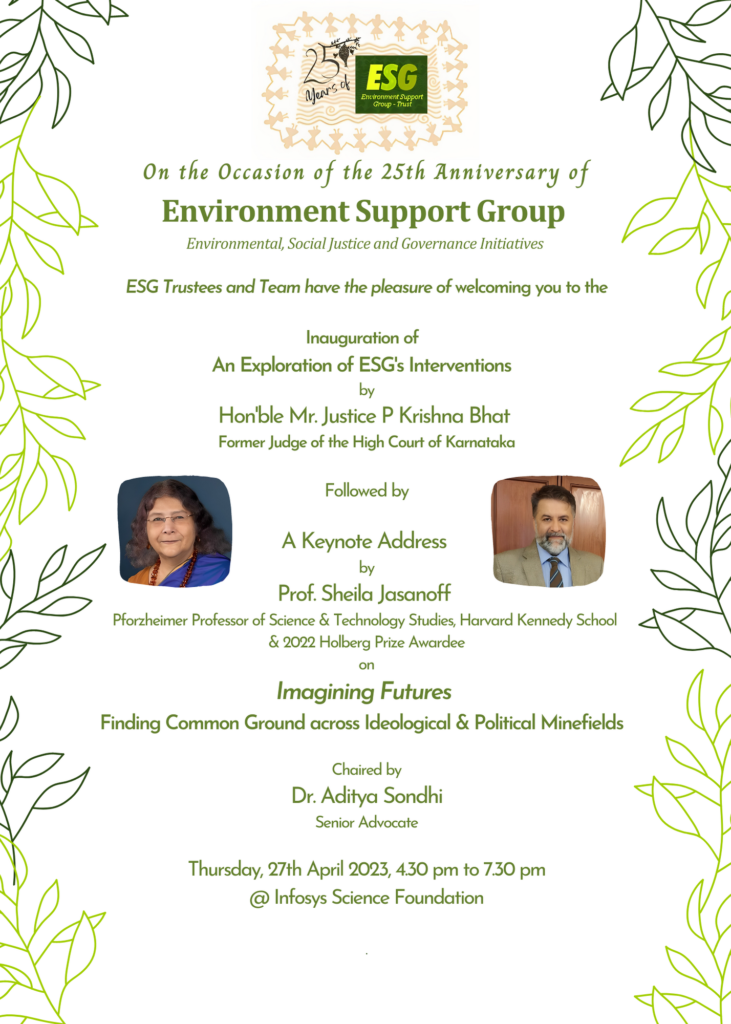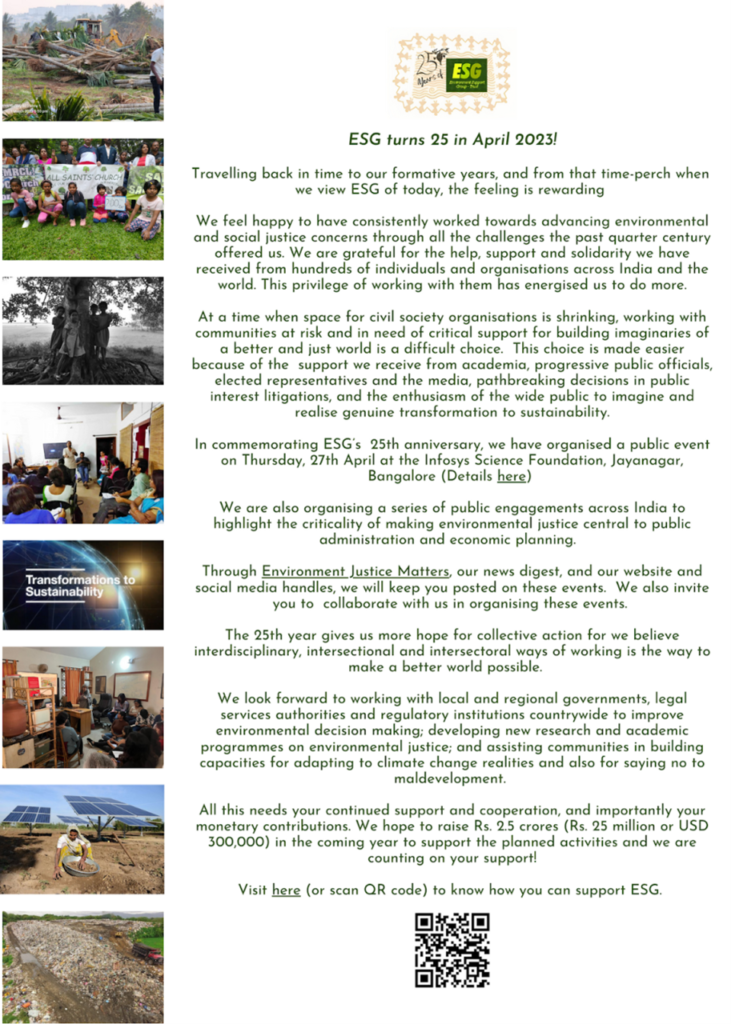Environment Justice Matters Vol. 4 Issue 06: ESG is 25!

Vol 4. Issue 06
#25yearsofESG
We are very happy to share with you: ESG is 25!
If we travel back in time to our formative years, and from that perch, view ESG of today, the feeling we derive is one of satisfaction. It comes from having worked consistently and tirelessly advancing environmental and social justice causes, which has been possible due to the help, support and solidarity we have received from hundreds of individuals and organisations across India and the world! Most importantly, we share with dozens of communities unique bonds of friendship having worked with them in advancing their struggles to secure justice. In the process, we have gained significant understanding of the yawning gaps that exist between promises made in the UN Charter on Human Rights and the Constitution of India, on the one hand, and the lived realities of today, on the other.
As we look ahead, the massive challenges in securing human wellbeing and of our planet – the only living planet in the universal expanse which renowned astronomer Carl Sagan chose to describe as ‘this pale blue dot’ – is daunting. Every day we work to build bridges across political and ideological chasms to secure our common future with imaginaries of intelligence and compassion overpowering those forces that wish to divide, rule, extract and conquer.
These are not mere words and phrases for us; every day we work through collective action with progressive coalitions to ensure every earthly-wrong decision made is challenged. We identify pragmatic to deeply democratise decision making, so we can look back 25 years hence and regard that we have done everything in our means and within our realms of capacities in making our world a better place.
As we work with this commitment, we count on your support, solidarity and cooperation. Surviving in the India of today as a functional civil society organisation, is clearly not easy. Which is why we believe ESG’s Silver Jubilee is a celebration of the critical importance of civil society – which we consider a strong pillar for sustaining liberal democratic governance.
To celebrate this spirit, we have organised a series of events this year, starting on Thursday, 27th April 2023 and we invite you to participate.
Details can be viewed here: https://tinyurl.com/ESGis25.


We are most grateful to Infosys Science Foundation for providing us their Bangalore facility to commemorate these events.
Here’s how you can support ESG through its 25th year!

Support ESG: https://esgindia.org/new/support/
Right to Clean Environment
In July 2022, the United Nations General Assembly passed a resolution declaring the right to a clean, healthy and sustainable environment as a universal human right. Recently, the UN Human Rights Council has encouraged states to adopt policies and legal frameworks to give force to this right. But this move is facing resistance from USA, China, Japan and Russia, and India too!
The Right to a Clean Environment, and its implications to tackling air pollution, was discussed by a panel of experts in the Second Webinar of ESG’s Webinar Series on Tackling Pollution. This webinar held on 6th April assayed steps taken by different countries to respond to air pollution, the kind of provisions required to tackle air pollution in India, and analysed if India will join the community of nations in acknowledging this human right as fundamental to its action plans tackling air pollution. The full report is accessible here, and the video recording can be found here.
The panel for the session (L to R): Bhargavi S.Rao (Moderator, ESG), Leo F. Saldanha (ESG), Dr. Sarath Guttikunda (Founder/Director, Urban Emissions), Chee Yoke Ling (Executive Director, Third World Network), David Boyd (UN Special Rapporteur on Human R ights and the Environment), and Randeep D (Commissioner, Health & Family Welfare)
Worryingly, new research by the Harvard TH Chan School of Public Health links pollution and exposure to fine particulate matter (PM 2.5), to increased risk of dementia! Meanwhile, microplastics are being reported from just about everywhere, including in Indian sea salts as per a Mongabay report.
Biodiversity Losses and its Impact

The silent calamity of the world is the drastic decline in biodiversity. In Mexico, about 300,000 bees have died due to mass fumigation of crops sprayed with undisclosed pesticides made by Bayer/Monsanto.
Unsustainable fishing practices and trade in Kakkanad, Kerala, is pushing threatened species of sharks and stingrays closer to extinction. In the Kanha Tiger Reserve in the Western Ghats, a study by the Wildlife Institute of India found invasive alien species, like Lantana camara and Pogostemon benghalensis have caused significant decline in the native plant species thereby adversely affecting the ecosystem and the food chain. Another study published in Environmental Health Perspectives indicates that a decline in insect pollinators has led to changes in the availability and price of healthy food resulting in about half a million premature deaths. Biodiversity loss and over exploitation is also impacting the availability of medicinal plants and their associated traditional knowledge.
Promoting Tiger Conservation and Forest Conservation Act Dilution at once
The Status of Tiger In India 2022 Report prepared by the National Tiger Conservation Authority (NTCA) records an overall increase in the tiger population in India. However, in the Western Ghats, there is a decline in tiger occupancy outside Protected Areas. The report warns: “Rapid development of linear infrastructures and several hydro-electric projects could potentially disturb the existing corridors and natural habitats and further alter the genepool.”
But just days after releasing this report, a proposal has been floated to divert 177 hectares of forests in the Western Ghats for laying a 400 KV D/C Quad Transmission line from Goa to Tamnar. Another 6.8 km tunnel (Anakkampoyil-Meppadi tunnel road) has been proposed to link Kozhikode and Wayanad where preliminary work has begun without any Environmental Impact Assessment (EIA) of damage to biodiversity.
It is reported that in the last 5 years, the Indian Government has diverted over 88,903 hectares of forest land (larger than Mumbai and Kolkata put together) for non-forestry purpose, with the highest of over 19,424 hectares being for road construction, 18,847 hectares for mining, 13,344 hectares for irrigation projects, 9,469 hectares for transmission lines and 7,630 hectares for defence projects.

Prime Minister of India, Narendra Modi, came to learn of the consequences of such reckless diversion of forests for non forest purposes, which his administration is spearheading, when on a recent visit to Bandipur National Park he was unable to see a tiger. This lack of sighting was reportedly caused by multiple visits his security staff made into the forest, thus scaring away wildlife.
Diversion of forests to non-forest purposes by the Indian Environment Ministry is the single largest reason for forest loss in India. This is increasing biotic pressure on remaining forest areas, resulting in fragmentation of forests and loss of biodiversity, increasing human-wildlife conflict, and threatening rights and livelihoods of forest dependent communities. The population of tigers, for instance, appears to have achieved the threshold level resulting in about 40% of the population living outside Tiger Reserves, which has created unique problems, and there is actually an effort now to control tiger population with contraceptives!
The controversial Forest (Conservation) Amendment Bill, 2023, widely held as a massive and destructive dilution of existing law, was introduced in the Lok Sabha. This drew protests. But instead of sending it to the Parliamentary Committee on Environment and Forests, controversially it was sent to a Joint Committee of the Parliament which is filled with ruling party members. This Bill which is likely to be introduced in the monsoon session of the Parliament, proposes dilution of definition of ‘Deemed Forest’ as laid down by the Supreme Court Judgment in TN Godavarman v Union of India, and also proposes to exempt requirement of Forest clearance for forest within 100 km of the international border and forests within 10 hectares alongside railways, roads and notified forest land. It further permits establishment of zoo/safari and ecotourism facilities inside forests.
Community Conservation

Indigenous communities with their deep cultural traditions and ways of living have depended on and protected biodiversity. The indigenous Idu Mishmis tribe in Arunachal Pradesh have built mythologies to prevent hunting certain animals, including the tiger. This unique conservation mode involves traditionally designating community conservation areas and has protected wildlife over millennia. Yet, the Government of India now proposes to notify the Dibang Wildlife Sanctuary as a tiger reserve, and this has been staunchly opposed by the All Idu Mishmi Students Union on grounds that over half of their forests will be declared a reserve and will be out of bounds to them. Which makes them ask what is the reason for declaring the Dibang valley as a reserve when the entire local community protects the tiger as a brother.
In stark contrast, in the Kali Tiger Reserve forest officials have come up with initiatives to involve the communities living in the reserve in conservation efforts. The initiative is titled SWAYAM-ENEC (Saving Wildlife in Association with Young Aspiring Minds — An Eco-development and Nature Education Centre). Similarly, in Rajasthan, villages that were facing fodder shortage created pasture development and management committees in different districts and successfully restored large expanses of pastureland.
Tackling Climate Change

Carbon pricing as the way towards decarbonisation has been the basis on which government led climate action is poised for decades now. Yet, with volatile carbon markets, finding money to boost investment in renewable energy is more than challenging. As countries continue to fail in keeping with the Paris Climate Accord commitments, carbon capture and storage (CCS) technology is being touted as a saviour, even as investing in such measures is considered quite a distraction from critical steps needed to tackle global warming.
Protecting original growth forests, grasslands and wetlands is key to tackling climate change. But there is an added benefit- securing public health. Scientists report in Nature’s Communications: Earth and Environment that “lower number of infections was found in municipalities with more forested areas, and with a low level of fragmentation, which probably is related to the potential capacity of the Amazon Forest to absorb PM2.5.” This finding is instructive to prevailing efforts which claim greenery lost to urbanisation and infrastructure development can be replaced by planting trees, as is the case being made by the Indian Environment Ministry in justifying massive loss of forests in Nicobar.

A new study published in Nature Geoscience suggests glacial lakes have increased in the Himalayas by roughly 47% between 2000 and 2020, or an increase of 179 lakes per decade, resulting in roughly 2.7 gigatonnes of under-water ice loss. This has frightening consequences to the fragile region which is being ripped apart by reckless infrastructure development. Meanwhile, the El Nino is developing sooner than expected and could lead to reduced rainfalls in India, and cause droughts and heat waves across the Pacific, and contribute to loss of coral reefs in the west. However, Indian Met Department says the monsoon this year will be normal despite erratic El Nino factors.
On a funny note, it was discovered that the expert panel on climate change before the US Congress House Transportation Committee about Infrastructure Investment and Jobs, were at sea when asked “What percent of our atmosphere is CO2?”!
Commons and Commons Users, Threatened
The Karnataka Horticulture Department has begun imposing bizarre restrictions in Bengaluru’s Cubbon Park. Having picnic lunches, playing games, and couples sitting close to each other is being prohibited in the most astonishing manner: calling them out on loudspeakers! This has wrought widespread condemnation and an online petition.

Meanwhile, Bruhat Bengaluru Mahanagara Palike (BBMP) continues to commodify and financials commons, lakes in this case According to a recent tender document, Rs. 6.2 crore has been kept aside for maintenance work of 40 lakes in various parts of the city. Out of the 201 lakes under the BBMP, it plans to restore and carry out developmental activities at 69 lakes in 2023-24. This expensive strategy of Bangalore comes in stark contrast to similar efforts to save lakes in Tamilnadu, and a fraction of the cost.
The National Green Tribunal has come down on the Karnataka State Pollution Control Board for neither preventing pollution in the Chandapura lake, nor taking action against violators. In a status report filed by the KSPCB to NGT in another matter, lakes in Doddaballapur and Bashettihalli upstream of Hesaraghatta have been found to be heavily polluted with sewage.
Urban and Infrastructures Maldevelopment?

Just before Karnataka elections were announced, the State Government decided to invest over Rs. 200 crores in Bengaluru to redesign its streets, a project undertaken in coordination with Canada-based World Design Organisation (WDO). But the city is still run without an elected council, and there is absolutely no urban design and planning department as part of the municipality, despite a Constitutional requirement per the Nagarpalika Act, 1992. Does this mean that foreign agencies, not local communities, will now decide how the city is designed and functions?
The under construction 210 km long expressway connecting Delhi and Dehradun includes 20 kms that passes through Rajaji National Park, an ecologically sensitive area. It iss claimed impact on wildlife will be reduced with 340 metres long Daat Kali tunnel and also an elevated section of the expressway. To ensure the expressway is built in time for inauguration in January 2024, night-time construction has also been allowed.

In Karnataka, K-RIDE proposes to cut 1500 trees for suburban rail. BBMP has already granted permission for cutting 746 trees for the 1st phase of one corridor. But questioning such reckless felling of trees, or demanding that these development are preceded with due consultation with the impacted communities, is resulting in arrests of peaceful protestors, as residents protecting Bengaluru’s infamous Sankey flyover, or villagers protesting the disastrous Dr. Shivarama Karanth Layout discovered.
Judicial Interventions for Sustainable Development
While the Supreme Court has disturbingly held that land acquisition for Shivarama Karanth Layout must be undertaken under the colonial Land Acquisition Act, 1894, instead of the Land Acquisition Relief and Rehabilitation Act, 2013, in another decision, the Supreme Court upheld the quashing of the acquisition proceedings initiated to acquire nearly 8000 acres of land for Vedanta University on grounds there has been no application of mind regarding environmental aspects which compromises nearby wildlife sanctuaries, two rivers and the ecology.

On the controversial issue of Waste to Energy projects, the Supreme Court refused to hear an application for stay on operation of Okhla Waste-to-Energy incinerator plant established within 10km of the eco-sensitive Okhla bird sanctuary and without permission of the National Board of Wildlife.
In a confusing verdict, the National Green Tribunal has constituted a High-Powered Committee to revisit the Environmental Clearance granted by MoEFCC as it found the same to be grossly insufficient. The proposed project involves establishment of an airport, transshipment terminal, solar park and a township in the Great Nicobar Island, home to indigenous tribes. Even as the Tribunal claimed “great significance not only for economic development of the island and surrounding areas of strategic location but also for defence and national security”. The NGT also said it would not interfere with the permission accorded for forest clearance – 130.75 sq. km of forests will be destroyed, involving felling 8.5 lakh trees, effectively destroying the island.
In a significant development a committee constituted by the NGT to investigate the case of illegal felling of trees and road construction from Madikeri to Kukke Subramanya, through Pushpagiri Wildlife Sanctuary, has decided to initiate criminal action against those involved in the decision.
[This edition of Environment Justice Matters was compiled and presented by Nidhi Hanji.]
Environment Support Group (Trust)
1572, 36th Cross, Ring Road , Banashankari II Stage
Bangalore 560070. INDIA
Tel: 91-80-26713560 | Voice/Fax: 91-80-26713316
Website: esgindia.org Email: [email protected]
Follow our Facebook, Instagram,Linkedin and Twitter page
- ESG is registered to secure support under the Corporate Social Responsibility (CSR) scheme of the Ministry of Corporate Affairs. Reg No. -CSR00017320
- Environment Support Group (ESG) is eligible to receive foreign donations/grants per the Foreign Contribution Regulation Act (FCRA)
- All donations to ESG from Indians are eligible for tax exemptions as per Sec. 80G of the Income Tax Act.
More details about ESG’s Financial Reports and Statutory Approvals are accessible here: https://esgindia.org/new/financials-and-statutory-clearances/
Your Monetary Contributions Keep Us Working

Donate Via UPI
(This QR Code is applicable ONLY to Indian/Domestic donors. Post UPI payment, please share donation details to [email protected] along with PAN – statutory requirement.)

